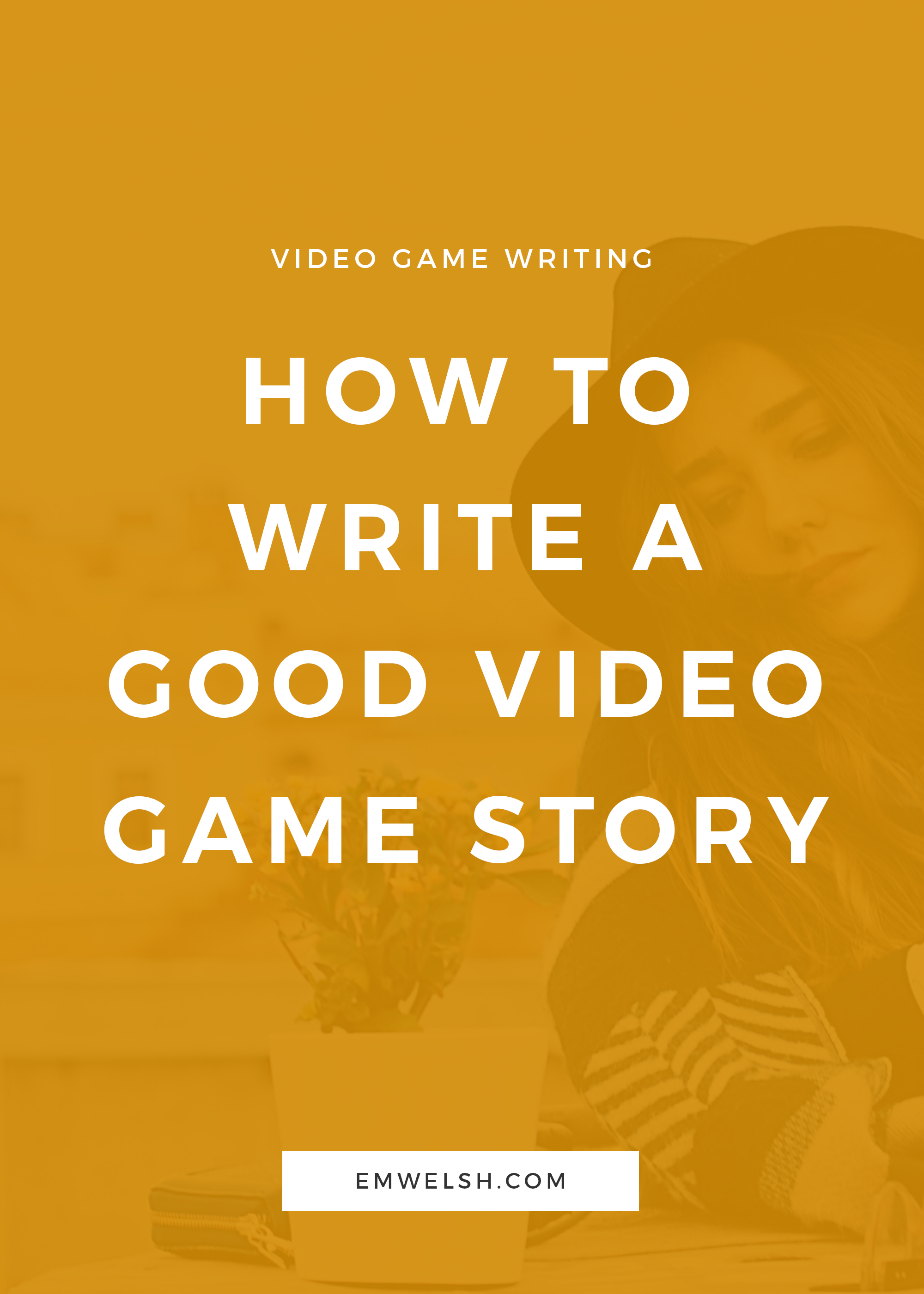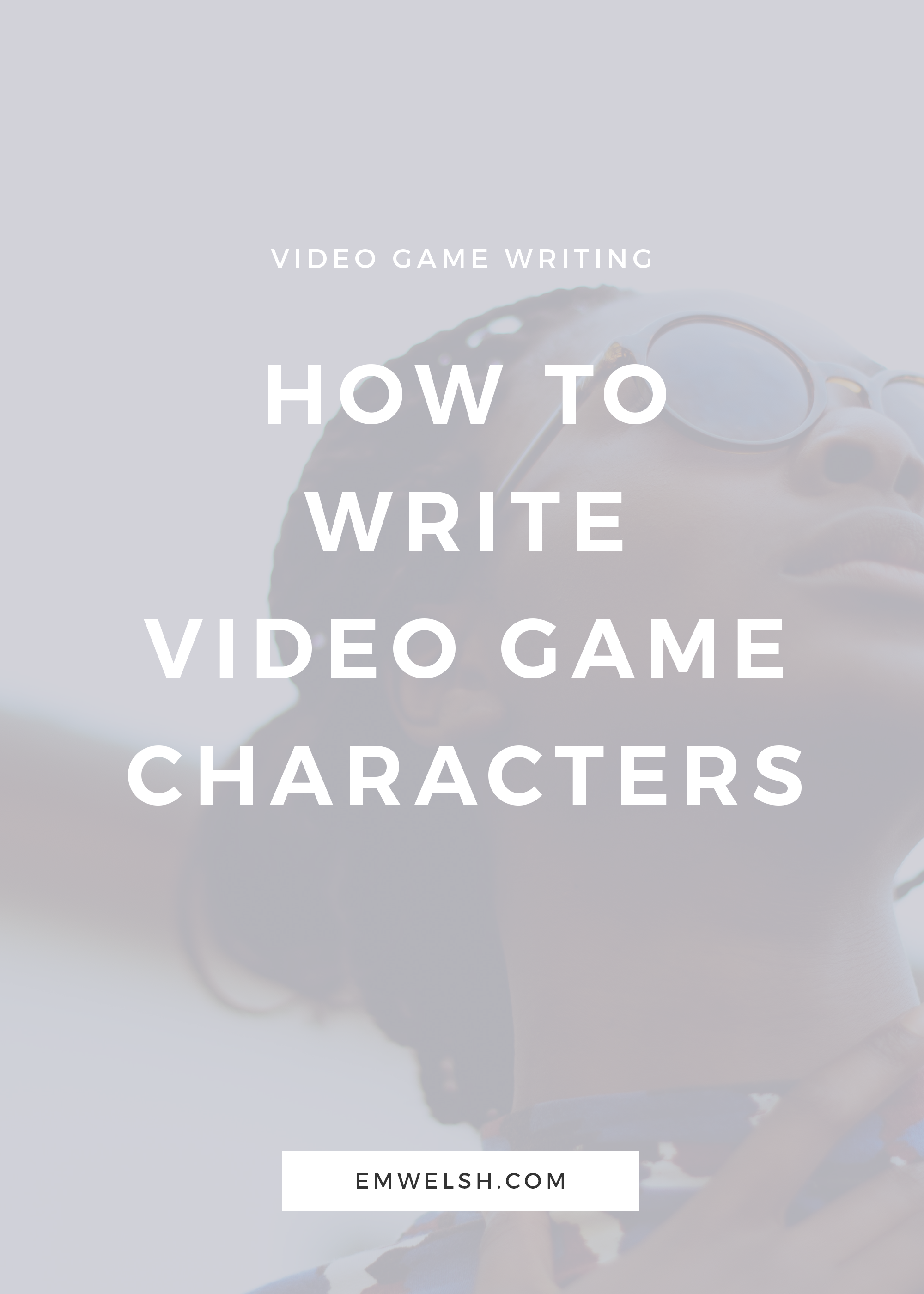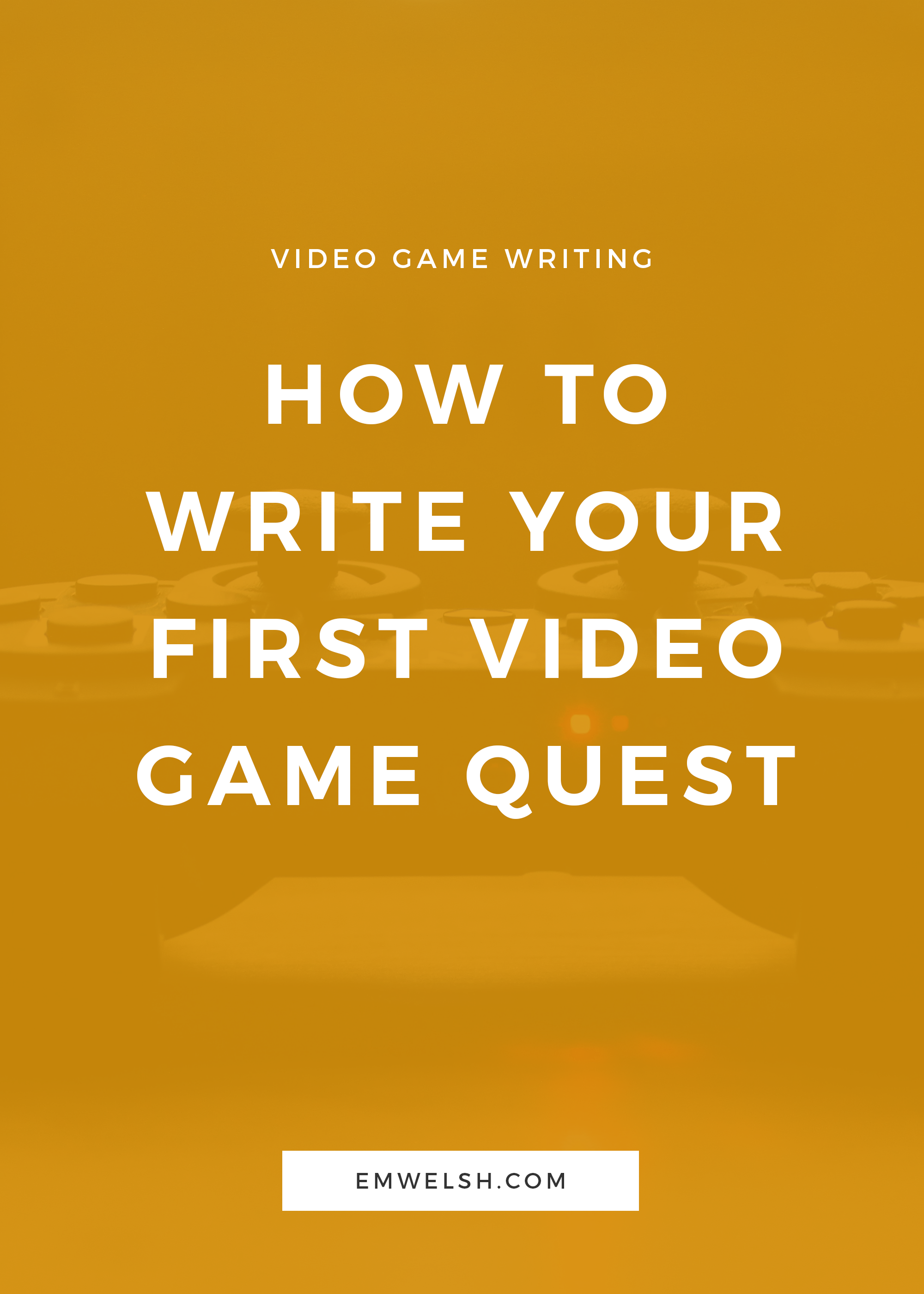How to Write a Good Video Game Story
/Whether you’ve been playing video games since you were a kid or have recently noticed them as an exciting new medium to tell your story in, you may be wondering how to write a good video game story.
After all, video games seem deeply complex and overwhelming—not to mention all the development work behind them. Is writing a video game on your own really possible, let alone a good one?
Like with any storytelling skill, writing a video game story takes practice. But the barrier to entry is much lower than you may realize. And while you shouldn’t just dive into a 100+ hour video game script on your own, writing a shorter game is completely plausible.
The trick is in the organization of your approach! Using this three-part series on how to write a video game, you’ll have the foundation you need to start writing your first video game script.
In this post, you’ll learn how to write a good video game story—meaning the exact order to approach your writing—and in the following two posts afterward you’ll learn more about world building and character development. Then, you’ll be ready to write your first quest and eventually the whole story!
What makes a good video game story?
There are so many features of a good video game—the combat, the world, the mechanics, the interactivity. But these features aside, what makes a good video game story?
Just like with any storytelling medium out there, there is no secret formula to what makes a good video game story. One video game can have turn-based combat, last over 100 hours, and have zero choices for the player to make, whereas another game can be 20 minutes long and have nothing but choices.
This doesn’t even account for preferences, which always dominate what we believe makes a good story, no matter the medium. Some people can’t stand a game that is all story—they want exploration and time to pursue random side quests or odd jobs—whereas others would be okay if video games didn’t have combat at all!
Despite all these differences, there remains one element that every video game has and must consider—the player-character dynamic.
No matter your preferences, a good video game keeps this unique dynamic in mind, the dynamic that says both you—the player—and the main character are one, so no matter what, you cannot allow the main character to do something the player does not believe they would do.
In other words, the player is playing a video game—versus watching a movie—because they want to feel they have control, and every good video game story gives the player that sensation, even if there aren’t any choices to be made or no visible story to follow.
What are the elements of a video game narrative?
The two elements of any good video game narrative are:
Player-character dynamic
Interactive space for the player to explore
While we’ve already discussed the player-character dynamic, to dive into it a bit further, this dynamic ensures that the player never has a moment when they think to themselves, “Wait, my character wouldn’t do that.” (Which is often why second-person in prose hardly works.)
A good video game story understands that balance, even if their main character has a distinct personality, like Aloy in Horizon Zero Dawn. Sure, she may have certain traits that are unlike the players, but she never refers to instances that the players aren’t aware of or speaks of things in her past they didn’t already know about. This is so often why many video games rely on the crutch of amnesia—something to avoid, for the most part. It makes that player-character dynamic easy.
In addition to the strong player-character dynamic, there is also interactivity. How interactive the game and story can be varies, but every video game story must offer some form of interaction, otherwise it’s a movie, albeit a very long one.
This interactivity comes in many different forms. In Persona 5, it can be something like choosing to water plants versus watching TV, or it can be the exploration of an entire world like it is in Skyrim, where every item can be touched and picked up. Though this element may not be the first thing you think of when writing a story, it is just as important to remember when writing your video game script as the player-character dynamic.
How do you write a video game?
Though writing a video game isn’t as simple as just following a few steps, there is an approach that is the most efficient and leads to fewer problems in the long-run. This means starting big and broad, then getting specific as you know more and more. And of course, always keep that player-character dynamic in mind.
Step 1. Outline the major storyline
Whether you have several different possibilities for an ending or one canon story, you’ll want to start out writing your script by outlining the major storyline.
If your story has a lot of different endings or outcomes, you may find this difficult. However, it’s important you have a major outline of the canon story, despite all these possibilities. Writing this outline often means noting all the major events every character—regardless of their decisions—must go through and listing three different ending possibilities.
Of course, if you are writing a linear story without possibility, then the major storyline is a bit easier to write, as you don’t have to allow your story room to have alternate endings and outcomes.
But no matter your story’s path—with possibility or not—providing yourself with a large outline of the major plot points will save you an enormous amount of trouble later on, even if you consider yourself someone who doesn’t outline.
Step 2. Decide what type of game it will be
After you know the general structure of your story and how things will go, you’ll want to decide what type of game it will be.
You might be thinking the game’s mechanics don’t matter to you as a writer, but they absolutely do. Think of it like trying to write a novel without deciding whether it’s in first or third person—it’s just not possible and it’s a not a light decision—it changes the entire framework of your story.
So, before you go any further with your story, decide what type of game it will be:
Action-adventure
Role-playing game (RPG)
First-person shooter (FPS)
Puzzles
There are other types, of course, and many hybrids between two—such as an action RPG—but these are the core games you’ll find. The more you play, the easier it will be for you to distinguish and decide which type of game would be best for your story.
Step 3. Develop your world
After you’ve decided what your game will be, you’ll want to begin developing your world. You may feel inclined to create your main character first, and if you have a strong vision for them, that is okay.
But more often than not, the main character is far less important than the world. This is because your players will be viewing the world a lot more than they will be viewing themselves, even if it’s a third-person game.
In a video game, the world is from your character’s perspective, so in many ways, it’s how players experience character development.
For that reason, you’ll want to flesh out your world, its culture, lore, and so forth before you dive into all your character development, in addition to determining just how much “world” your players can explore, something we will discuss in part two of this series.
Step 4. Create your main characters
Once you have your world established—or at least as much as possible—you can then move on to creating your main character and any other prominent characters, such as villains, companions, and so forth.
Creating characters for video games isn’t much different than creating them for other stories until you introduce possibilities to the narrative that can change how characters behave. You also interact with these characters from a first-person mindset, so approaching that relationship can be tricky for new writers, something we’ll cover in the third and final installment of this series.
Step 5. Create a flowchart of your major story
After you have the characters and the world of your story, you’ll want to create a flowchart of your main story. This will show any deviations in the story, should they emerge or small changes if certain things occur. You can also use this flowchart to show where side quests could appear, though it is best to focus on the main story for now/
Step 6. Start writing the major story
Once you have all the major pieces of your story, you can start actually writing the major story. Focus on canon cutscenes or one version of the story at first, then deviate after you have one core version.
You can write the main story either as a summary, or you can actually begin to dive into scene-writing.
How you do it is up to you, but starting with cutscenes that have minimal interactivity is a great basis to ground your story in. If you don’t believe me, consider the fact that most video games have “cutscene only” versions on YouTube where you can watch the story like a movie. Use those cutscene versions as inspiration, and write that bare-bones version of your story before you begin to dive into interactivity, side quests, and other possibilities.
Step 7. Add in side quests, NPCs, and other small details
Once you’ve written the major story, you can add in all the fun stuff.
For some, that may mean adding in side quests or filling the world with non-playable characters. For others, it may mean it’s time to start writing out the alternate versions of your story and planning how different players achieve different endings.
If you’re not sure where to start, here are some common things you can add to fill out your story:
Non-playable characters - People who your player can interact with. Often they may just have fun “barks” where they express their opinion, reveal information about the world, or even give you hints. Other NPC’s offer side quests and rewards with a more expansive storyline.
Side quests - If your story is big enough, you may want sidequests sprinkled throughout your world. These side quests can be related to the world, culture, lore, or explore backstories of some of your other characters. They don’t have to affect the main plot at all, or they can be detrimental to the success of the mission.
Items - The objects your characters use go beyond weapons and armor. There can be notes, letters, and other things that help with quests to include as well. A jewel can have a story behind it or an abandoned home can be filled with things left behind. The sky's the limit when it comes to items—so get creative! (And use a spreadsheet to keep track of all your ideas.)
There are more tiny details in a game, but these are the most common ones you’ll see and often where you’ll have a lot of fun and be able to really differentiate your story!
What do you need to write video games?
Contrary to what you may think, you don’t need much to write a video game. Depending on the scope of your game, you may only need yourself—or you may need a team of writers. But beyond that, until you get to development, you only need two things:
Experience playing video games
Just as the saying goes that if you want to be a writer, you’ve got to read a lot, so it goes that if you want to be a video game writer, you’ve got to play a lot of games.
While I think this is true for all types of writing—if you want to write movies, you absolutely must watch them—it’s especially true for video games because you must not only consider the story but the gameplay element.
True, writers typically don’t code the games and really determine the gameplay mechanics. But when video game writers don’t consider the mechanics of the game as part of the story, there can be cause for serious disconnect amongst players.
For instance, in games like Horizon Zero Dawn and The Witcher, the heroes are hunters often tasked with taking down beasts and other troublesome foes. This changes how the world interacts with them and the quests they’re given as much as it shapes how combat feels.
Additionally, it’s incredibly difficult to imagine and write movement in a video game—and all the possibility—if you’ve hardly ever played one. Though you may not need to figure out different types of ammo or weapon upgrades, you need to be able to envision how your story moves in a three-dimensional world filled with possibility, not just a linear narrative.
For more information on this and a list of different games to play, check out why video games help all types of storytelling.
Video game writing script software
Though there is no “official” way to write a video game script, there are a few different software you can turn to for help.
Word Processor - Yes. As simple as it may seem, a word processor like Google Docs or Pages can be used to write a video game script. Don’t believe me? Check out the template I used to write my first quest here.
FinalDraft - Though this software is used for writing screenplays, it can also be used to write video game scripts as well!
Twine - While I’ve never used Twine, it is said to be a great way to write a non-linear story. Plus, you can publish your work anywhere after it’s done to find fellow developers to help you work on it!
Inklewriter - Though technically Inklewriter is a permanent beta, it offers a nice alternative to Twine should you wish to write a more interactive story instead of the branching style that Twine offers.
Keep in mind that no matter what software you choose, it is much better to have a finished game than to have an unfinished game. Even a quest completed becomes something you can show in your portfolio, so choose whatever software and style best suits you, and then write the game that comes most easily to you.
Often this is going to be the more simple idea, so try not to write a triple-A RPG for your first go. A whole team is behind those types of games, so shoot for something like Undertale or A Stanley Parable for your first try.












